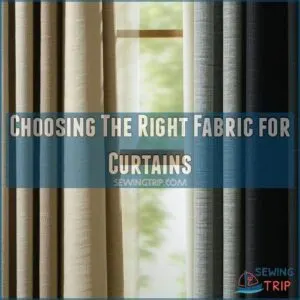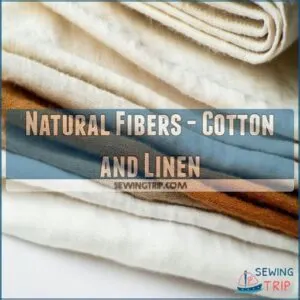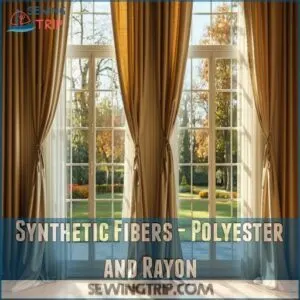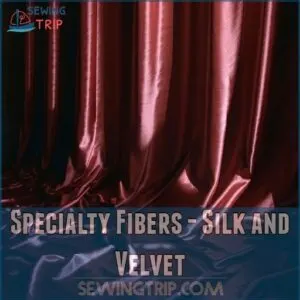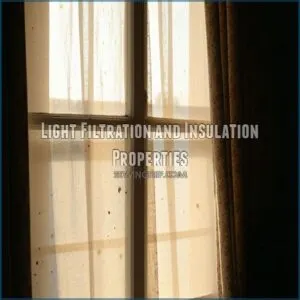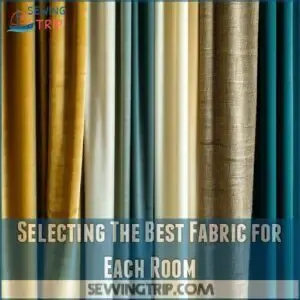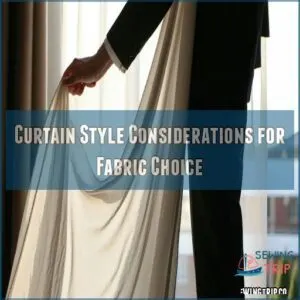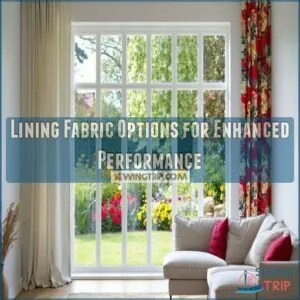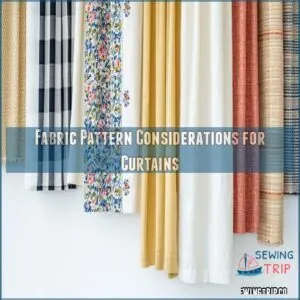This site is supported by our readers. We may earn a commission, at no cost to you, if you purchase through links.
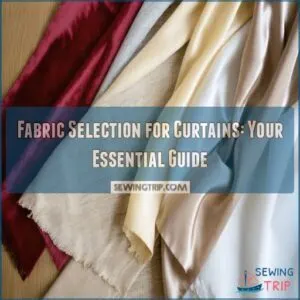 Selecting fabric for curtains is like choosing the perfect outfit for your windows—it needs to fit your style and function.
Selecting fabric for curtains is like choosing the perfect outfit for your windows—it needs to fit your style and function.
Cotton curtains are versatile, offering a casual vibe that feels like your best pair of jeans.
For a touch of elegance, linen adds sophistication, while silk transforms your room into a luxurious retreat.
If practicality is your goal, polyester is durable, like that reliable friend who’s always there.
Velvet, on the other hand, brings drama and warmth.
Consider your room’s needs for light, insulation, and maintenance.
Feeling intrigued? There’s more to uncover in the art of fabric selection for curtains.
Table Of Contents
- Key Takeaways
- Choosing The Right Fabric for Curtains
- Types of Curtain Fabrics Available
- Fabric Qualities for Curtain Performance
- Selecting The Best Fabric for Each Room
- Curtain Style Considerations for Fabric Choice
- Lining Fabric Options for Enhanced Performance
- Fabric Pattern Considerations for Curtains
- Measuring and Installing Curtains for Perfect Fit
- Frequently Asked Questions (FAQs)
- Conclusion
Key Takeaways
- You’ll want to consider your room’s function and desired ambiance when choosing curtain fabric. Heavier fabrics suit formal settings, while lighter fabrics work well in casual spaces.
- You should prioritize fabric properties like light control, insulation, and ease of maintenance. Select materials that meet your needs for privacy, energy efficiency, and cleaning convenience.
- You must carefully consider the type of fabric based on the room’s location. Bedrooms might benefit from blackout curtains, while kitchens need stain-resistant fabrics.
- You’ll need to factor in fabric weight and drape for the desired aesthetic. Heavier fabrics create a more dramatic look, while lighter fabrics offer a softer, more airy feel.
Choosing The Right Fabric for Curtains
Choosing the right fabric for your curtains can dramatically affect the room’s feel, balancing style and function like the perfect cup of coffee—strong yet smooth.
You’ll want to think about how much light you prefer.
You’ll want to think about the level of privacy you need.
You’ll want to think about how much time you’re willing to spend maintaining them.
Considerations for Fabric Selection
Choosing the right curtain fabric is like picking the perfect outfit—style and practicality matter.
Considerations include:
- Fabric budget: Don’t overspend, but don’t skimp.
- Maintenance ease: Opt for washable or dry-clean options.
When selecting fabrics, it’s also essential to think about the natural fibers like cotton, linen, or hemp that offer breathability and comfort, which can be further explored in what to ask when choosing fabric.
- Light control: Look for fabrics that filter or block light.
- Durability: Choose long-lasting materials.
- Privacy: Make sure there’s enough coverage, avoiding sheer surprises.
Room Type and Function
When thinking about room function, consider how curtains fit into the overall vibe.
Living room style demands both flair and flexibility.
In contrast, bedroom privacy calls for cozy, heavier fabrics.
Dining room elegance shines with rich textures, while kitchen practicality needs easy-to-clean materials.
For bathrooms, fabrics must resist moisture.
Tailor your curtain choice to each room’s decor and needs for a perfect match.
Natural Light and Insulation Needs
Imagine waking up each morning to the perfect balance of light and warmth.
Your fabric choice is key: let natural light pour in while keeping room temperature just right.
Opt for light filtration fabrics that offer energy savings, or go for blackout curtains for ultimate light control.
It’s all about harmonizing insulation and window treatments for comfort all year round.
Maintenance and Durability Requirements
Maintaining your curtains doesn’t have to be a chore.
Opt for fabrics with easy cleaning methods, like polyester or cotton, which promise durability and wrinkle-free options.
These materials offer longevity advice with minimal fabric care effort.
Remember, fabric weight affects longevity too—heavier fabrics might need extra TLC but repay you with added durability and a refined look.
Types of Curtain Fabrics Available
So, you’re ready to choose the perfect curtain fabric?
Let’s explore the many types available, from lightweight sheers to heavy, light-blocking options.
To find the ideal match for your style and needs.
Natural Fibers – Cotton and Linen
Cotton and linen, both natural fibers, offer unique benefits.
Linen, for instance, provides a strong yet airy texture and is known for its classic look with linen curtains.
Cotton gives you durable and easy-maintenance fabric; it’s like the trusty friend who always shows up.
Linen, airy yet sophisticated, adds elegance but needs a bit more care—like a high-maintenance partner who’s worth it.
Go eco-friendly with these natural, stylish choices!
Synthetic Fibers – Polyester and Rayon
Polyester and rayon stand out among synthetic fibers for curtains.
Polyester is the trusty workhorse—affordable, durable, and wrinkle-resistant, perfect for kids’ rooms or high-traffic areas.
Rayon, a chameleon of fabrics, blends a silky feel with a gentle touch, though it demands more tender care.
Weigh your options: Polyester vs. rayon—consider durability and care to suit your style.
Specialty Fibers – Silk and Velvet
In the realm of luxurious fabrics, silk and velvet stand out like royalty.
Their elegant appeal is undeniable, offering opulence and style.
However, with great beauty comes delicate care.
Silk curtain care demands professional cleaning to maintain its sheen, while DIY velvet curtains require careful handling to keep that plush look.
Choosing between silk and velvet depends on your lifestyle and maintenance willingness.
Blended Fibers for Hybrid Properties
Just finished exploring the luxury of silk and velvet? Now, think about blended fibers offering hybrid properties.
Explore cotton-linen mixes for a breezy vibe and polyester-cotton blends for extra durability.
Linen-silk combinations, on the other hand, fuse elegance with performance.
These blends don’t just toughen up your curtain fabric—they bring a fantastic balance and versatility to your curtain materials.
Fabric Qualities for Curtain Performance
When picking the right curtain fabric, you should consider how well it resists stains, filters light, and handles daily wear and tear.
Curtains not only dress your windows but also play a key role in controlling light, maintaining privacy, and making your home feel just right.
Stain Resistance and Easy Cleaning
Fabric stains can be a real headache.
To dodge coffee drips and mystery smudges, pick easy-care curtains treated with stain-resistant magic.
Performance fabrics are your trusty allies, designed to repel spills and simplify cleaning.
A bit of effort upfront means less scrubbing later.
Think of fabric care as a small investment in stress-free living and a stylish home.
Durability and Long-Lasting Appearance
So, you’ve got stain protection nailed. Now, let’s talk durability!
Choosing a high-quality fabric means less wear and tear.
Think of it like buying good shoes—they last longer.
Linen and polyester are champs for wrinkle resistance.
Cotton’s pretty tough too, but it wrinkles more.
Consider cleaning ease; some fabrics need dry cleaning, which adds up.
Ultimately, the best fabric depends on your lifestyle and how much maintenance you’re willing to handle.
Light Filtration and Insulation Properties
Beyond durability lies the art of managing your room’s ambiance.
Light filtration and insulation properties of curtain fabrics play a key role.
Whether you’re aiming for snug winter warmth or keeping the sun’s gaze at a comfortable distance, choosing the right fabric type and weight, such as using blackout curtains, can boost both thermal efficiency and energy savings.
Breathability and Air Circulation
When picking curtains, consider how air flows through your home.
Breathability is key.
For better air circulation and indoor air quality, choose fabrics that allow airflow.
Here’s a quick guide:
- Cotton and Linen: These natural fabrics breathe well.
- Light Polyester Blends: Offer a balance of durability and ventilation.
- Voile and Chiffon: Ideal for enhancing room ventilation and temperature control.
Selecting The Best Fabric for Each Room
Picking the right curtain fabric for each room can be tricky, but it’s essential for setting the right mood and function.
Whether you’re aiming for cozy comfort or sleek style, matching the fabric to the room’s needs makes all the difference.
Living Room and Dining Room Fabrics
Fabric choice in your living and dining rooms sets the stage for style and function.
Think about fabric durability and texture—cotton and linen can handle daily use while adding a cozy touch.
Light-filtering materials enhance ambiance, perfect for entertaining.
Play with color schemes that complement your furniture, creating a seamless flow.
Remember, the right curtains are like the cherry on top of your space’s decor.
Bedroom and Nursery Fabric Options
In your bedroom or nursery, choosing the right fabric means cozy nights and safe spaces.
Opt for breathable fabrics with soft textures to guarantee comfort.
Blackout curtains are a game-changer, blocking out light and creating a peaceful ambiance.
Also, consider toddler-proof fabrics for durability.
Mix safety and style, keeping your bedroom decor both practical and inviting.
Kitchen and Bathroom Fabric Considerations
Choosing curtain fabrics for kitchens and bathrooms can feel like picking between practicality and style.
Prioritize moisture resistance and stain resistance for durability.
You don’t want your curtains acting like bathroom sponges!
Look for materials that offer:
- Light control: Maintain privacy while allowing ventilation.
- Durability: Withstand frequent cleaning.
- Light blocking: Protect your privacy effectively.
Home Office and Study Fabric Selection
So, you’ve tackled the kitchen and bath? Great.
For these spaces, you want fabrics that offer privacy, good light control, and soundproofing with noise reducing curtains.
Think medium-weight curtains in a neutral color for a sophisticated aesthetic.
Durability matters, so choose a sturdy fabric.
Noise reduction is a plus, too.
Linen blends look great and offer a good balance of style and practicality.
Curtain Style Considerations for Fabric Choice
Choosing the right fabric for your curtains mirrors picking an outfit for your home, where each choice affects its overall style and mood.
Whether you’re aiming for a formal elegance with silk or a cozy vibe with cotton, understanding the role of fabric weight, drape, and color can transform your space from drab to fab.
Formal or Informal Ambiance
For a formal ambiance, opt for heavier fabrics like velvet or silk that add elegance and sophistication.
They drape beautifully, creating a refined look that’s perfect for traditional styles, much like how velvet fabric is used in formal wear such as luxurious evening gowns.
If you’re aiming for a more informal vibe, go for cotton or linen.
These lighter fabrics give off a relaxed, airy feel, perfect for casual, everyday spaces and effortless style.
Pattern and Texture Options
Your room’s style heavily influences the patterns and textures of your curtains.
Want a cozy vibe? Try plush textures and subtle patterns.
Bold patterns can energize the space, while delicate textures add elegance.
Whether you’re mixing and matching or sticking to a theme, balance fabric weight and curtain style to complement your room’s personality perfectly.
Color Scheme and Fabric Hue
Just as patterns add texture, the choice of color scheme and fabric hue can transform your space’s vibe.
Explore color psychology to pick hues that set the mood: soothing blues for calmness, vibrant reds for energy.
Understanding how different colors affect us is key, for instance, you can find products informed by curtain color psychology curtain color effects.
With today’s color trends and fabric dyeing techniques, matching your curtains with your decor becomes both art and science.
Fabric Weight and Drape
When picking curtain fabric, the weight and drape are like choosing a dance partner—get it wrong, and the whole room feels offbeat.
Heavy fabric? Expect a dramatic drape, best for spacious rooms.
Light materials flow gracefully, adding softness to smaller spaces.
Match the fabric weight to your room’s size and shape for perfect balance in style.
Lining Fabric Options for Enhanced Performance
Enhancing your curtains with the right lining fabric can make a world of difference, whether you’re aiming for better light control or looking to cut down noise.
You’ll find options like blackout, thermal, acoustic, and decorative linings that bring both style and function to your home.
Blackout Lining for Light Control
So, you’ve picked your curtain style? Great! Now let’s talk light control. Blackout lining is your secret weapon for a good night’s sleep. Here’s why you’ll love it:
- Blocks almost all light.
- Boosts privacy.
- Improves sleep quality.
- Helps save on energy bills.
Blackout lining is easy to add to existing curtains, too. It’s a simple upgrade with big payoffs.
Thermal Lining for Insulation
Are you tired of window drafts ruining your comfort?
Thermal linings can be your go-to solution for energy efficiency and climate control.
They keep your room snug in winter and cool in summer, providing year-round comfort.
Choosing the right insulating fabric for your curtains enhances thermal performance, ensuring you’re cozy without over-relying on heating or cooling systems.
This is where understanding the different types of insulating fabrics, such as moisture-wicking fabrics, can make a big difference learn more about fabric types for sewing projects.
Acoustic Lining for Noise Reduction
Picture your room like a cozy sanctuary. Acoustic lining can turn this dream into a reality by reducing noise and enhancing tranquility. Embrace silence with:
- Noise-canceling curtains that absorb sound.
- Soundproofing fabrics for peaceful vibes.
- Acoustic panels subtly blending in.
- Sound absorption materials transforming chaos into calm.
Who knew fabric could keep peace and comfort?
Decorative Lining for Aesthetic Appeal
Just finished considering acoustic lined curtains? Now, think decorative lining for a splash of artistic flair.
Lining color and patterns can shift your room’s mood, adding depth that plain curtains can’t muster.
Imagine butterflies or subtle stripes peeking through—lining texture and thickness play their parts, too, in creating aesthetic appeal that’s both chic and unique.
Embrace this artistic touch!
Fabric Pattern Considerations for Curtains
When choosing curtain patterns, think about how busy prints or bold stripes can add drama to a space, while solid colors offer a timeless feel.
Floral and geometric designs can enhance or balance your room’s ambiance, bringing just the right touch of nature or modern flair to your home.
Busy Patterns and Large Prints
Once you’ve picked the perfect lining, it’s time to focus on busy patterns and large prints. These bold choices can make your curtains the showstopper of any room.
Here’s how to rock them:
- Use large-scale patterns for dramatic impact.
- Consider the visual effect and room size.
- Make sure pattern placement complements decor.
- Make them your style’s statement piece.
Stripes and Geometric Patterns
Stripes and geometric patterns add visual impact to curtains, influencing room dimensions and style.
Whether you want your room to feel taller or cozier, the right pattern placement on your fabric does the trick.
Striped curtains give height, while geometric designs add depth and interest.
Floral and Nature-Inspired Patterns
Dreaming of a garden indoors? Floral and nature-inspired patterns bring the outdoors in.
Consider these options for your curtains:
- Bold floral prints for a statement look.
- Subtle nature motifs for a calming effect.
- Varying pattern scales to suit your space.
- Seasonal changes reflected in fabric color palettes.
Choosing the right floral pattern is a snap!
Solid Colors and Textures
Solid colors in curtains offer a timeless canvas, bringing calm and control to your space.
Whether you’re opting for the crispness of linen or the coziness of cotton, the right fabric weight makes all the difference.
Texture plays its part too—it’s the secret sauce that adds depth. So, go ahead, let your fabric choice create a visual appeal that whispers sophistication.
Measuring and Installing Curtains for Perfect Fit
Getting the right fit for your curtains is like finding the perfect jeans—precision is key!
First, measure the curtain length, considering the window casing.
Choose a rod that complements your style and supports the fabric’s weight.
Gather your installation tools and use hanging techniques that make sure a sleek look.
Don’t rush; a careful installation gives a polished finish.
For confident control over your space, make sure everything aligns, letting your curtains frame your windows beautifully and functionally.
Perfect fit achieved!
Frequently Asked Questions (FAQs)
How do I choose the best curtains?
Choosing curtains feels like finding a perfect blend of style and function.
Think about the room’s purpose, lighting needs, and your vibe.
From airy sheers to cozy blackouts, match the fabric to your lifestyle essentials.
How to choose a lining material for curtains?
Opt for lining materials like blackout for complete darkness, thermal for energy savings, or cotton for a lightweight feel.
Consider your needs: light control, temperature regulation, and privacy.
It’s not just practical; it enhances style too.
What are the different types of curtains?
Imagine your windows, bare or beautifully dressed? Sheer, regular, or blackout curtains—each offers a unique style and function. Which best suits your needs? Let’s find out!
What is the best fabric for living room curtains?
For living room curtains, you can’t go wrong with linen or cotton.
Linen offers an airy, sophisticated feel, while cotton provides durability and easy maintenance.
Both fabrics balance style and function, creating a welcoming and stylish space.
Which fabrics are used for making curtains?
Curtains are crafted from fabrics like cotton for a casual vibe, linen for a breezy feel, silk for luxury, velvet for insulation, polyester for durability, and sheer materials like voile for light filtering.
Each offers unique qualities.
What fabrics are unsuitable for curtains?
Avoid using fabrics like paper, cardboard, or plastic for curtains.
They lack durability, flexibility, and aesthetic appeal.
Fabrics that absorb odors or are highly flammable, like untreated cotton near heat sources, are also unsuitable.
What fabric is best to use for curtains?
Did you know that 73% of people prefer natural fibers?
Linen’s durability and airy elegance make it a top pick for curtains.
It drapes beautifully, ensuring your space gets light and stays stylish.
Plus, it’s eco-friendly!
How to choose fabrics for curtains?
Evaluate your room’s light, privacy, and style needs.
Choose durable fabrics like polyester for low maintenance, or luxurious silk for elegance.
Consider cotton for versatility or blackout fabrics for complete darkness.
Match your choice to decor.
What fabric should I use to line curtains?
Worried about curtain lining? You can’t go wrong with blackout fabric for maximum light blocking, insulation, and privacy.
It’s also durable, enhancing your curtains’ lifespan while helping to maintain a comfortable room temperature.
What are the 3 desirable properties of curtain fabric?
You want curtains that look great, last a while, and are easy to care for. Consider durability, aesthetic appeal, and ease of cleaning when choosing your fabric.
How do I clean velvet curtains effectively?
Gently vacuum velvet curtains using a soft brush attachment weekly.
Spot-clean stains quickly with a damp cloth and mild detergent.
For deep cleaning, consult professionals or use gentle machine washing on a delicate cycle, then air dry.
Can curtain fabrics impact indoor air quality?
Curtains’ fabrics can dramatically affect indoor air quality.
Materials like polyester might release VOCs, while natural fibers like cotton and linen are generally safer.
Opt for breathable, hypoallergenic options to make sure your living space stays fresh and healthy.
Are there hypoallergenic curtain fabric options?
Consider hypoallergenic curtain options like organic cotton and linen.
These natural fibers resist dust mites and mold, making your home both stylish and safe.
For added protection, choose curtains with tight weaves or those treated for allergens.
How do I prevent curtain fabric fading?
Think of your curtains as sunscreen for your home; protect them by using lining or UV-protective finishes to block harmful rays.
Regularly rotate them and use tinted windows or shades to reduce direct sunlight exposure.
What curtain fabrics are eco-friendly?
Opt for linen, hemp, or organic cotton for eco-friendly curtains.
These natural fabrics are sustainable and biodegradable, offering a chic aesthetic.
They minimize environmental impact while maintaining style and functionality in your home.
Conclusion
All in all, selecting the right fabric for curtains can transform your space from drab to fab with just a simple switch.
The key is aligning your needs with the fabric’s qualities, like how cotton offers versatility while silk oozes luxury.
Consider light, insulation, and maintenance needs when making your choice.
With the right fabric selection for curtains, you can effortlessly enhance your home’s style and function.
Now, dress those windows and watch the magic unfold!

